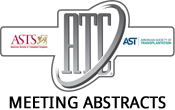2016 American Transplant Congress
NAD+ Promotes Allograft Survival Independently of CD4+CD25+Foxp3+ Regulatory T Cells.
CD4+CD25+Foxp3+ regulatory T cells (Tregs) play a central role in the maintenance of immune tolerance and T cell homeostasis. It is known that Tregs promote…2016 American Transplant Congress
Designing and Synthesizing a Novel Highly Selective Immunoproteasome Inhibitor That Promotes Long Term Heart Allograft Acceptance While Reducing Plasma Cells and Donor Specific Antibodies.
Antibody mediated rejection (AMR) is one of the most important barriers to improving long-term transplant outcomes. Traditional therapies for AMR do not deplete the source…2016 American Transplant Congress
NK-Activating MCMV Strain Is Associated with Increased Murine Renal Transplant Injury.
Background: CMV contributes to inferior longterm kidney transplant survival. In a murine model, NK cells infiltrate MCMV infected renal allografts in greater numbers than in…2016 American Transplant Congress
Type-I Interferon Induced Cross-Competition of IL-10 Signaling and Its Role in the Abrogation of Transplant Tolerance.
Plastic Surgery, Johns Hopkins University, School of Medicine, Baltimore, MD.
PurposeA growing body of evidence shows that induction of long term transplant survival by “costimulation blockade” (CoB) regimens is impaired by inflammatory responses. In particular,…2016 American Transplant Congress
Pediatric Access to Kidney Transplantation Under KAS.
Background. Under the kidney allocation system (KAS) implemented on Dec 4, 2014, pediatric (ped) priority is now based on Kidney Donor Profile Index (KDPI) <35%…2016 American Transplant Congress
Who Should Decide? Potential Living Kidney Donor Preferences for Making Decisions About Risk.
1Yale U, New Haven; 2Northwestern U, Chicago; 3U Pennyslvania, Philadelphia.
BackgroundTransplant centers debate how to manage risks to potential living kidney donors (LKDs) when there is a lack of consensus about reasonable donor risk .We…2016 American Transplant Congress
Mycophenolic Acid Product Discontinuation Prior to Conception: Analysis of Pregnancies in Kidney Transplant Recipients.
Mycophenolic acid (MPA) products are considered teratogenic and transplant centers report discontinuing MPA in female kidney recipients anticipating pregnancy. Data were collected by the National…2016 American Transplant Congress
B Cell Signature Profiling in Kidney Transplant Patients on Thymoglobulin.
Purpose: B cell subsets could be used as biomarkers to modulate therapy regimens in kidney transplant patients. B cell subsets occur with varying proportions within…2016 American Transplant Congress
Induction Therapy with Depleting Antibodies in Low Immunological Risk Renal Transplant Patients Treated with a Steroid Free Regimen – Comparison of Alemtuzumab vs. Antithymocyte Globulin.
Induction therapy with depleting antibodies reduces rejection rate and potentially improves efficacy of steroid free regimens after renal transplantation.This prospective, single-centre, cohort study evaluated cumulative…2016 American Transplant Congress
Resolution of Undefined Etiology of Respiratory Infections in Lung Transplant Patients with Unbiased Metagenomic Sequencing.
Study Purpose A high number of post-transplant infections with respiratory symptoms remain unresolved, despite routine testing for the common respiratory viruses. Using an open metagenomic…
- « Previous Page
- 1
- …
- 65
- 66
- 67
- 68
- 69
- …
- 180
- Next Page »
